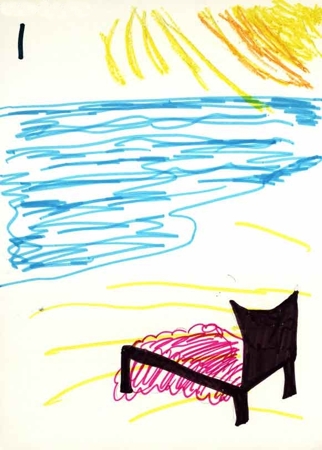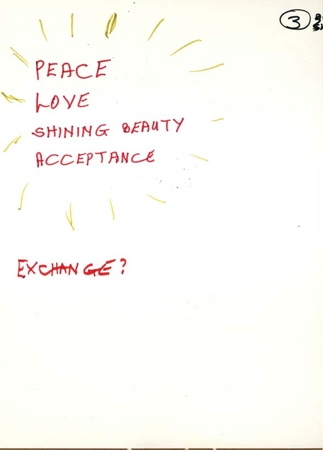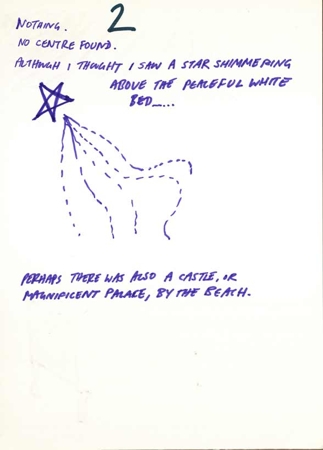In that way I wanted to examine Jung’s assertion that images are held in the conscious but are repressed by it to the unconscious. My experiment asserts that indeed the conscious mind has the capacity to hold and remember inner images, which people usually associate with the unconscious to the effect that they believe the conscious cannot contain those images. My experiment did not go as far as to prove the act of repressivism, but demonstrated that the conscious mind is indeed much more capable than was thought before.
Once participants had finished drawing on paper their impression from the first stage (‘place’), I took them again on the journey, asking them to find the centre of the place – and then come back again and draw it or write it down. Then I took them into the third stage, where I asked them to go ‘inside’ the centre, or beyond it. I have used Bays’ term ‘drop through’ to guide participants to go further, and accept a ‘gift’.
In this third stage, participants went through the place, and the centre of the place, symbolising environment and the individual’s place in the environment. The stage of the ‘gift’ was beyond the individual. I was attempting to find what people can say about the inner call, without me suggesting that there exists an inner call. Five participants simply described the gift that they received, while the other three participants were enthusiastic in revealing that they felt an actual presence of something or someone giving them their gifts.
We then had a group discussion with each participant reflecting on the stages, on what he or she felt, saw or heard, and on their impression of the images and the texts they have created (fig. 112).

Figure 112: Image from participatory art workshop (still image from film The Collective Hearts, 2008.) Image © Gil Dekel.
The first stage, a ‘place’ was reported by participants in the form of a room, or a theme of nature. The most commonly theme was a scene on a beach (see two examples from two participants, figs. 113-114). Participants reported:
‘In front of me was this vast ocean, disappears into this really bright sky which was all enveloping. But the ocean is up [at] me, its really calm lapping at my feet.’
I noted that participants’ descriptions of their inner visions did not consist only of what they saw, but also of what they felt from the experience of observing the images. The inner image and the feeling around it were united in the descriptions:
‘My daughters… I could feel presence but I could not see them on this beach somewhere… and the left and the right which were just an expansion of this beach. Somebody came with this golden key. That was a key to this red box, to open… I felt really powerful… [inside the box was] a warm strong self… this kind of a collective-identity… almost God, almost [a] spiritual power.’
‘A feast of words and colours and perfume. I was absolutely entranced by the perfume of wavelet in spring time. It was just words that came to me, words with halo around them. It was about finding peace, finding love, finding the shining beauty and acceptance.’
‘I go straight to the light… and I feel secure. And I see this landscape in the distance. It’s a sparkly different colours ball; I have never seen anything like it.’
‘And I just thought ‘peace’… it was just my own little bubble in the world.’
‘Very powerful wind and you just enjoy leaning into it.’
All participants used words and imagery (figs. 115-118).





